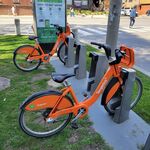steveintoronto
Superstar
Rather than quote the 'bike lane behind parked cars or in front of' exchanges, all very good, btw, I think the solution for Bloor especially, but applicable to many cases, is for parking one side of the street, as most streets now have and are set-up to do, and a bi-directional bike lane the other side. Like all compromises, it's not perfect, but it does eliminate the mindless passenger door exit (often children), pedestrians who step into the bike lane without looking, whereas they wouldn't into a full street, and most importantly, it leaves *sight lines* unobstructed, both for cyclists, motorists sharing the same road, and intersecting roads, where the motorist's sight line is also blocked by that line of parked cars further out in the roadway, and thus they're forced to nose out across the bike lanes to see what's coming.
The downside is parking only one side of the street, so merchants will find that to bitch about (whether their concern is baseless or not). Bi-directional bike lanes offer the huge benefit of passing opportunities if there's no oncoming bikes, and psychologically too, you're not 'cycling a tight-rope' like on many spots on Bloor.
I too find Bloor a very iffy and dangerous ride, one must not only guess what their next move is, but also what everyone else's is too. I see people flying along there without a clue, passing on your right, jumping red lights, and just generally being jerks.
Toronto has a long way to go to match 'cycling cities'. And part of the problem is general cycling mentality as well as poor infrastructure. They conspire together to stymie moving this forward.
On a separate note: I had a collision on Adelaide two nights back in the westbound lane near Bay, some idiot with no lights and incompetent in other ways just suddenly stopped mid-lane. Didn't look, signal, or think. No damage, although I wanted to hit the guy for being such an idiot, but that evening was full of dangerous events coming west across the city on what should be 'safe' routes.
So last night, coming west across the core from lower Cherry St, I decided to avoid that situation again, and took the Lakeshore path. Other than about half of the cyclists not having lights, the *flow* was much more predictable, and it was possible to discern oncoming cyclists w/o lights by their blocking the lights of those behind them. That's still a risk, but much more predictable. I normally avoid the Lakeshore path as when packed, it's almost completely unpredictable, and the wanna-be jocks are as dangerous as the morons in doing stupid things without thinking.
Lighting from the Sherbourne to Spadina stretch wasn't great, but sufficient, far better than Adelaide across the same stretch. I'll use the waterfront route now as my default option on nights where it's not overcrowded down there.
The downside is parking only one side of the street, so merchants will find that to bitch about (whether their concern is baseless or not). Bi-directional bike lanes offer the huge benefit of passing opportunities if there's no oncoming bikes, and psychologically too, you're not 'cycling a tight-rope' like on many spots on Bloor.
I too find Bloor a very iffy and dangerous ride, one must not only guess what their next move is, but also what everyone else's is too. I see people flying along there without a clue, passing on your right, jumping red lights, and just generally being jerks.
Toronto has a long way to go to match 'cycling cities'. And part of the problem is general cycling mentality as well as poor infrastructure. They conspire together to stymie moving this forward.
On a separate note: I had a collision on Adelaide two nights back in the westbound lane near Bay, some idiot with no lights and incompetent in other ways just suddenly stopped mid-lane. Didn't look, signal, or think. No damage, although I wanted to hit the guy for being such an idiot, but that evening was full of dangerous events coming west across the city on what should be 'safe' routes.
So last night, coming west across the core from lower Cherry St, I decided to avoid that situation again, and took the Lakeshore path. Other than about half of the cyclists not having lights, the *flow* was much more predictable, and it was possible to discern oncoming cyclists w/o lights by their blocking the lights of those behind them. That's still a risk, but much more predictable. I normally avoid the Lakeshore path as when packed, it's almost completely unpredictable, and the wanna-be jocks are as dangerous as the morons in doing stupid things without thinking.
Lighting from the Sherbourne to Spadina stretch wasn't great, but sufficient, far better than Adelaide across the same stretch. I'll use the waterfront route now as my default option on nights where it's not overcrowded down there.
Last edited:






